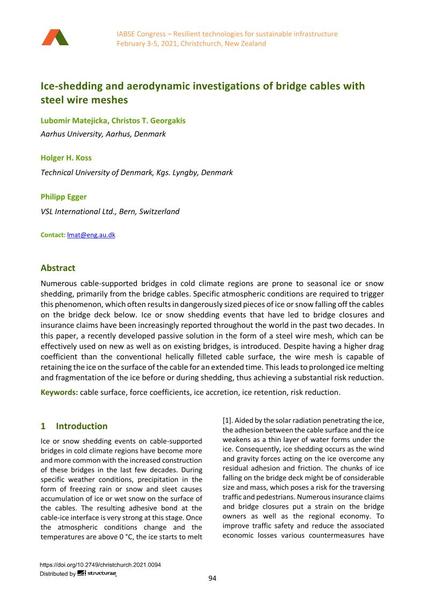Ice-shedding and aerodynamic investigations of bridge cables with steel wire meshes

|
|
|||||||||||
Bibliografische Angaben
| Autor(en): |
Lubomir Matejicka
(Aarhus University, Aarhus, Denmark)
Christos T. Georgakis (Aarhus University, Aarhus, Denmark) Holger H. Koss (Technical University of Denmark, Kgs. Lyngby, Denmark) Philipp Egger (VSL International Ltd., Bern, Switzerland) |
||||
|---|---|---|---|---|---|
| Medium: | Tagungsbeitrag | ||||
| Sprache(n): | Englisch | ||||
| Tagung: | IABSE Congress: Resilient technologies for sustainable infrastructure, Christchurch, New Zealand, 3-5 February 2021 | ||||
| Veröffentlicht in: | IABSE Congress Christchurch 2020 | ||||
|
|||||
| Seite(n): | 94-102 | ||||
| Anzahl der Seiten (im PDF): | 9 | ||||
| DOI: | 10.2749/christchurch.2021.0094 | ||||
| Abstrakt: |
Numerous cable-supported bridges in cold climate regions are prone to seasonal ice or snow shedding, primarily from the bridge cables. Specific atmospheric conditions are required to trigger this phenomenon, which often results in dangerously sized pieces of ice or snow falling off the cables on the bridge deck below. Ice or snow shedding events that have led to bridge closures and insurance claims have been increasingly reported throughout the world in the past two decades. In this paper, a recently developed passive solution in the form of a steel wire mesh, which can be effectively used on new as well as on existing bridges, is introduced. Despite having a higher drag coefficient than the conventional helically filleted cable surface, the wire mesh is capable of retaining the ice on the surface of the cable for an extended time. This leads to prolonged ice melting and fragmentation of the ice before or during shedding, thus achieving a substantial risk reduction. |
||||
| Stichwörter: |
Risikoreduktion
|
||||
